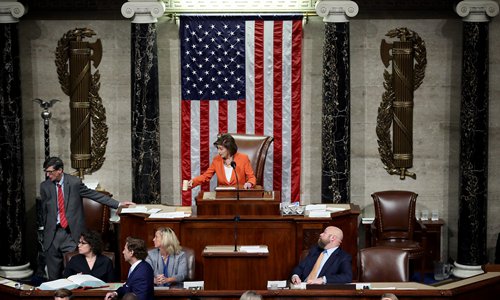Rubber-stamped stopgap measure of $480b hike only for a few weeks
US Congress averts default with bill

House Speaker Nancy Pelosi ends a vote by the US House of Representatives on a resolution formalizing the impeachment inquiry into US President Donald Trump Thursday in Washington, DC. Congress formally opened a new, public phase of its presidential investigation Thursday as US lawmakers voted for the first time to advance the impeachment process against Trump (See story on Page 2). Photo: AFP
US lawmakers rubber-stamped a short-term bill to lift the nation's borrowing authority Tuesday, averting the threat of a first-ever debt default - but only for a few weeks.
The Democratic-controlled House of Representatives voted along party lines to pass the stop gap $480 billion hike, which advanced from the Senate on October 7 after weeks of heated debate.
"It's about the kitchen table, it's about our economy, the global economy, but it's also about our constitution which says the full faith and credit of the United States shall not be in doubt," Democratic House Speaker Nancy Pelosi told reporters ahead of the vote.
Democratic leaders had spent weeks underlining the havoc that a default would have wrought, including the loss of six million jobs and $15 trillion in household wealth as well as increased costs for mortgages and other borrowing.
Republicans refused to offer any of their own votes to avert the crisis, and even blocked Democrats who control Congress from lifting the limit on their own, via a simple majority.
But the party dropped its blockade in the Senate last week, ending for now an impasse that risked leaving the federal government incapable of securing and servicing loans after Monday.
The new arrangement merely kicks the can down the road, possibly to complicate another major funding deadline - a shutdown that would begin from December 3 when the government's coffers theoretically run out.
The borrowing cap may yet turn out to be less pressing, however.
Economists estimate that the nation will reach the new, revised debt limit sometime in mid-December or early January - slightly later than the December 3 date that Congress originally projected.
The US spends more money than it collects through taxation so it borrows money via the issuing of government bonds, seen as among the world's most reliable investments.
Around 80 years ago lawmakers introduced a limit on how much federal debt could be accrued.
The ceiling has been lifted dozens of times to allow the government to meet its spending commitments - usually without drama and with the support of both parties - and stands at around $28 trillion. But Republicans in both chambers of Congress have this time objected, saying they refuse to support Biden's "reckless" taxing and spending plans.
In reality, raising the debt ceiling doesn't authorize new spending - it merely pays for expenses that both Republican and Democratic administrations have already committed to.
"This is about meeting obligations that the government has already incurred, including from the bipartisan COVID[-19] relief or legislation passed in 2020," Pelosi said.
"Only 3 percent of the current debt that we're addressing here has been incurred during the Biden years."



